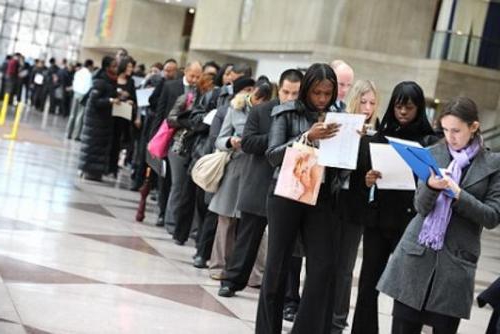The concept of natural unemployment is characteristic of a market and mixed economy. We will find out what causes this phenomenon to occur, whether it should be fought, and what this struggle is about.
What is natural unemployment?
The term in the 60s of the XX century was proposed by economists Milton Friedman and Edmund Phelps independently of each other.
Natural unemployment includes such a decrease in the level of employment that occurs as a result of changes in the structure of the labor market: the emergence of new vacancies and the disappearance of old ones. Sometimes its emergence is promoted by state policy.

Even if the law on parasitism is in force in the country, there will always be at some point in time a certain number of “loafers”. Three main reasons why a person may not have work: unwillingness to have it, dismissal and the beginning of work. There are always vacancies and job seekers, but this does not mean that there really is nothing to do in the country.
Strict correspondence of workplaces and the number of economically active citizens of the right qualifications is not only a utopian, but also an irrational idea. If the actual unemployment rate does not exceed natural, then employment in society can be considered full. If it is much less than natural, then there is over-employment.
But if the share of those who want but cannot find work starts to increase, we can talk about the appearance of real problems with employment in the country. In this case, employment will be incomplete.
Causes of Natural Unemployment
Talking about the need to eliminate such a phenomenon is advisable only after establishing the reasons for its occurrence. The causes of natural unemployment are due to economic progress and the availability of constitutional rights and freedoms in people. Labor is a right, but not a duty of a person, unless, of course, the law on parasitism does not apply in the country. Equally, a person has the right to change his place of work and look for more suitable conditions.

For example, not everyone after dismissal immediately begins to work in a new place. Someone has to be a job seeker for some time. Someone passed the final exams at the university yesterday and is still not working, but just started looking for their place in the sun, although it is already considered an economically active unit of society. Someone is ready to work, but he is not satisfied with the average market income, and he is waiting for better times. Natural unemployment also includes temporary downtime for people with a seasonal profession.
Natural unemployment is also caused by large social benefits. We do not consider the category of people who are satisfied with “living on an allowance,” but even a hardworking person, confident that tomorrow he will have something to buy bread, will take a while with the consent to the first job offer. He will sort out the proposals, trying to find a higher salary, more comfortable working conditions, more convenient schedule. Perhaps he even decides to undergo retraining.
The development of labor laws and trade unions also contributes to some extent to the growth of unemployment. Employees know what they can count on, and strive to find the best possible conditions, which in itself increases the duration of the search.
Providing good conditions to employers costs a pretty penny, and they prefer to measure seven times before offering new vacancies, or even completely reduce staff due to the impossibility, for example, to pay the minimum wage established by law. This reduces the supply of jobs.
Is a lack of work natural for housewives and senior citizens?
Naturally, but this is not our case. Natural unemployment does not include those categories of "vacationers" who do not intend (do not want or cannot) find a job, as well as citizens on sick leave or on vacation.

We are talking about full-time students who only study and do not work part-time in their free time. About pensioners who have already worked hard enough for the good of their homeland. About housewives who realize themselves in housekeeping. About prisoners, tramps, invalids and patients of psychiatric hospitals. Finally, about those who simply stopped searching for work, and have not yet decided what to do next.
Types of Natural Unemployment
There are three main types of reasons for reduced employment: frictional, structural, and cyclical. Frictional and structural unemployment are types of natural unemployment.
Frictional unemployment is inevitable and even desirable for a market economy. It occurs when people change their place of employment. In this case, a person usually initiates the termination of labor relations: due to a change of place of residence, because of disagreements with the bosses, because of a low salary, because of a desire to change the scope of activity. This also includes the first entry into the labor market after graduation or after maternity leave.
Structural unemployment is caused by structural changes in the economy, and therefore has a longer duration than frictional. Scientific and technological progress leads to the introduction of new achievements in production or to the decline of certain sectors of the economy. As a result, some skills become unclaimed. Holders of disappeared professions are forced to become unemployed, and for them, the search for a new source of income is a tedious and lengthy process. They have to learn new knowledge and skills, and sometimes change their place of residence. But this phenomenon is also inevitable.

Cyclical unemployment is not natural. It occurs during economic problems, when production drops and mass layoffs occur. In such periods, all three types take place simultaneously. That's just the duration of the job search is already due not to the pickiness of the applicant, but to the elementary lack of a vacant place.
Of course, there are many special varieties that do not always uniquely relate to one of the above groups. Let's say the state can set a minimum wage at a level that exceeds the equilibrium. This will cause a reduction in vacancies, as organizations will not be able to afford to pay such a salary. As a result, applicants would already be happy to work for less money, but no one invites.
Or the activity may be seasonal. For example, in the summer a person works, and in the winter he is actually unemployed, but he does not look for another place.
The market mechanism itself suggests that sometimes someone will remain out of work, as any enterprise may go bankrupt. At least 30% of individual entrepreneurs “burn out” during the first three years of their existence. Large companies fall apart less often, but each such case is more tragic, since it affects the fate of several hundred people.
Finally, the development of economic sectors is uneven, therefore, at one and the same time, there may be a shortage of personnel in some sphere, and in another, their excess.
Can natural unemployment change and why?
The rate of natural unemployment varies depending on the level of development of the economy of a particular country and other conditions. Sometimes this rate increases. The reasons for this are legislative norms and demographic features. For example, as mentioned above, decent benefits increase the duration of the search for a suitable place, and hence the natural unemployment rate.
This level may increase along with an increase in the share of youth among applicants. The more “fresh” labor resources enter the market, the higher the competition and, again, the longer the duration of a job search.
More and more women are abandoning the role of housewives, preferring material independence. This also increases competition in the labor market and provokes an increase in the natural level of unemployment. A similar result is given by migration processes.
According to economists, the optimal level for developed countries is in the range of 4-6%. In the UK, France and the USA it is 5-6%. In Sweden and Japan - 1.5-2%. The natural unemployment rate in Russia is 5-7%.
The indicator can not only grow, but also fall. For example, in war conditions, when the number of labor is declining and everyone has to work for the good of the country. Or at the stage of economic recovery, when there are many new vacancies.

Is full employment achievable?
In practice, a situation where absolutely all economically active citizens work is hardly possible. Unless it is a small society, forced to live in very limited resources. In primitive times, for example, people had to procure food, fire, protect territory, etc. every day. No one was left idle.
Now that technology does a lot for a person, and money is the main incentive to work, full employment and natural unemployment are considered synonymous. Unemployed is one who does not have a job, but wants to have it and is actively looking for a suitable offer. People who do not work just because they don’t want are not considered unemployed and are not taken into account when calculating the level of natural unemployment.
There is even the concept of hidden unemployment, when everything seems to be in office, but the required amount of goods is not produced, and incomes are miserable pennies. For example, if an enterprise is on the verge of bankruptcy and employees are part-time or go on forced leave.
Moreover, natural unemployment provides a certain reserve of labor resources. Indeed, the need for them is constantly changing: new places are created, old ones are eliminated. Without a certain “stock” of personnel, the functioning of the economic system will be difficult.
Natural unemployment rate calculation
Given that frictional and structural forms are natural unemployment, the formula for calculating the latter is simple: structural unemployment plus frictional.
In practice, calculating an indicator is difficult. Already at the stage of identifying the total number of unemployed, problems arise. The calculation results will always have an error.
For example, some people in various surveys identify themselves as unemployed, but in reality they are not, because they do not work anywhere just because they do not want it. Some citizens receive income informally or are employed in the informal sector.
As well as not every person who decides to change the place of employment, is registered with the employment authorities. Therefore, experts in the field of statistics, calculating the indicators for the next month, do not know about the new "loafers", and as a result, even frictional and structural unemployment are calculated inaccurately.
Unemployment and inflation
As already mentioned, among the causes of "natural" unemployment are listed and the actions of the state. Therefore, the state also has ways to regulate its level. If the natural unemployment rate has excessively increased or fallen, the Phillips curve will tell you how to adjust the indicator.
Why do this? There is a theory of the natural rate of unemployment. It is widely used by the governments of many countries. According to this theory, the optimal level of inflation can be achieved only when natural unemployment occurs.True, the level that is optimal for the economy is not always socially acceptable.
The English economist A. Phillips in 1958 proposed a demand inflation model that describes the relationship between unemployment and average income growth. Phillips studied statistics over several years and found that there is an inverse relationship between these indicators.

If unemployment is high, it means that there are enough human resources in the market, and this, at a minimum, allows organizations to avoid raising salaries, and at the very least to reduce them. Accordingly, the population has less money, purchasing power is falling and aggregate demand declining. And since there is no demand, then there is no point in bending prices, so the cost of goods decreases.
If the goal of the state is to achieve very little unemployment, then it can organize monetary and budgetary measures aimed at stimulating demand. For example, the industrial sector may receive subsidies from the state, which will expand production. Expansion will require an increase in jobs, which will solve the problem of employment. But in return, the country will receive increased inflation, so the main thing with such stimulating manipulations is not to “overheat” the economy. Otherwise, it will start all over again.
This effect only works when applied for a short period of time and in conditions of moderate inflation. Shocks of various kinds are not taken into account in the Phillips curve. Moreover, the relationship between the price level and unemployment is not always unambiguous, since sometimes these indicators grow simultaneously. This phenomenon is called stagflation. Although it contradicts the classical laws of economics, it exists and is not so rare.
If actual unemployment exceeds natural
Natural and actual unemployment should ideally coincide, because exceeding the actual level over the natural one leads to the country not receiving part of the gross national product (GNP).
This is characteristic of the recession stage in the economy, when, in addition to frictional and structural, cyclical unemployment appears. But in modern realities, this can happen under favorable circumstances. For example, if the state brings the size of unemployment benefits to the average wage in the country. It is logical that part of the population in such a situation draws up an allowance and will rest in peace.

The American economist A. Ouken created a formula that allows you to find out exactly what potential income was missed. Oaken's law states that every extra 1% of unemployment compared to the natural level reduces GNP by an average of 3%. The law is described by the following formula:
(Y - Y *) / Y * = b x (U - U *), where
Y is the actual GNP;
Y * - potential GDP;
U is the actual unemployment rate;
U * is the natural unemployment rate;
b = 3% (Ouken parameter).
The Ouken parameter is a value calculated empirically. In the 60s of the XX century, when Ouken derived his formula in relation to the American economy, he got 3%. For other countries and even for the States themselves, this parameter may be different in different years.
In addition, many economists argue that Ouken’s law is not law at all, since it is valid only for the US economy, and in other countries there is no such close relationship between GNP and unemployment.
If actual unemployment is less than natural
This happens at the stages of an economic boom. The economy is growing, new enterprises are opening up, the need for labor is increasing. As a result, the number of employees may exceed the average value. The economy is "overheating", which provokes a surge in inflation and closes the possibility of further growth.
As a result, the recession begins, which is accompanied by some increase in unemployment and lower prices.Ideally, after that the situation will stabilize, but if the country's economy is only developing and is unstable, then such a "balancing" threatens with serious shocks and a new significant recession.
Thus, we found that natural unemployment is a normal and even desirable phenomenon in a market economy. It is not necessary to fight it, but it is necessary to observe its level.